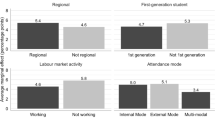Abstract
Area Health Education Centers (AHECs) play an important role in the recruitment and training of students to serve as practicing health care professionals in rural, primary care, and medically underserved communities. To analyze the relationship between the accumulated contact hours of past students in AHEC programs and their known matriculation into college. 5,189 students, whom participated in Indiana AHEC Network programs, were grouped into eight categories based on accumulated contact hours and matched against two college matriculation databases. The relationship between the number of accumulated contact hours and known college matriculation was statistically significant. The analysis of the data suggests two significant break points in which the number of accumulated contact hours appears to be correlated with increased known college matriculation. The findings indicate accumulated contact hours are significantly correlated with known college matriculation. Furthermore, two significant break points in contact hours at the 5 and 20 contact hours demonstrated increased correlations between program contact hours and known college matriculation. The results of this analysis between participation in area health education center programming and matriculation into higher education may be transferable to other areas of health education.


Similar content being viewed by others
References
Indiana Commission for Higher Education. (n.d.). Welcome. Retrieved from http://www.in.gov/che/.
Indiana University. (2013). About Indiana AHEC. Retrieved from http://ahec.iupui.edu/about-us-what-the-heck-is-ahec/.
National Student Clearinghouse. (2013). Who we are. Retrieved from http://www.studentclearinghouse.org/about/.
Seibert, E. M. (2005). Area health education centers and health education training centers: A well-kept secret. American Association of Nurse Anesthetists Journal, 73(5), 345–349.
U.S. Department of Health and Human Services Health Resources and Services Administration. (2006). The rationale for diversity in the health professions: A review of the evidence. Bureau of Health Professions. Retrieved from http://bhpr.hrsa.gov/healthworkforce/reports/diversityreviewevidence.pdf.
U.S. Department of Health and Human Services Health Resources and Services Administration. (n.d.). Recovery act funding for health professionals. Retrieved from http://www.hhs.gov/recovery/programs/hrsa/healthpros.html.
Walker, K. O., Ryan, G., Ramey, R., Nunez, F. L., Beltran, R., Splawn, R. G., et al. (2010). Recruiting and retaining primary care physicians in urban underserved communities: The importance of having a mission to serve. American Journal of Public Health, 100(1), 2168–2175.
Weiner, B. J., Ricketts, T. C., Fraher, E. P., Hanny, D., & Coccodrilli, L. D. (2005). Area health education centers: Strengths, challenges, and implications for academic health science center leaders. Health Care Management Review, 30(3), 194–202.
Acknowledgments
The contents of this article are solely the responsibility of the authors and do not necessarily represent the official views of the U.S. Department of Health and Human Services, Health Resources and Services Administration, Area Health Education Centers program. The project described was supported by Bureau of Health Professions, Health Resources and Services Administration Grant Number U77HP23068.
Author information
Authors and Affiliations
Corresponding author
Rights and permissions
About this article
Cite this article
Taylor, J.D., Kiovsky, R.D. A Study on the Correlation Between Program Contact Hours and the Successful Matriculation into College. J Community Health 39, 968–971 (2014). https://doi.org/10.1007/s10900-014-9840-z
Published:
Issue Date:
DOI: https://doi.org/10.1007/s10900-014-9840-z



